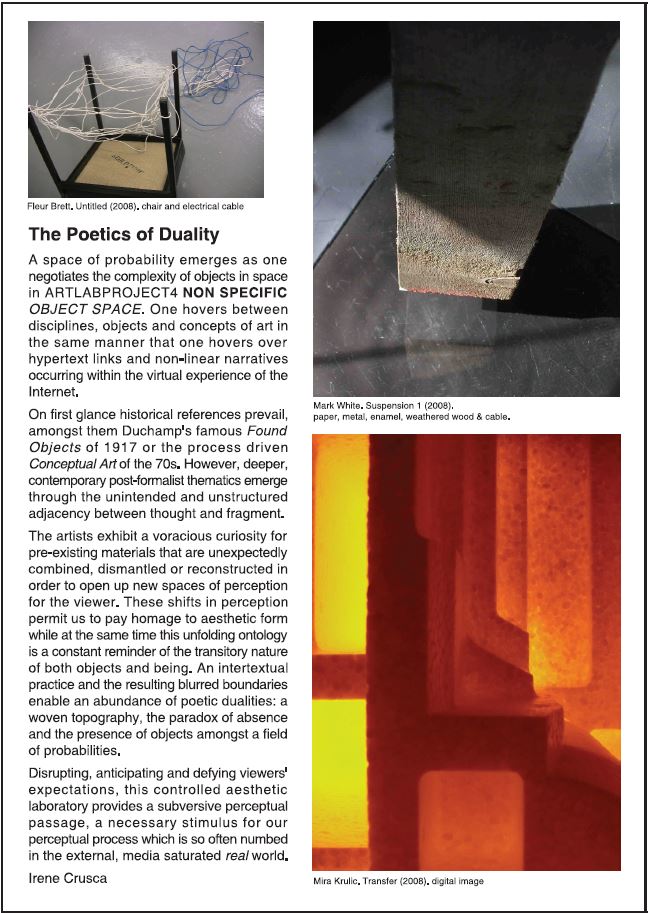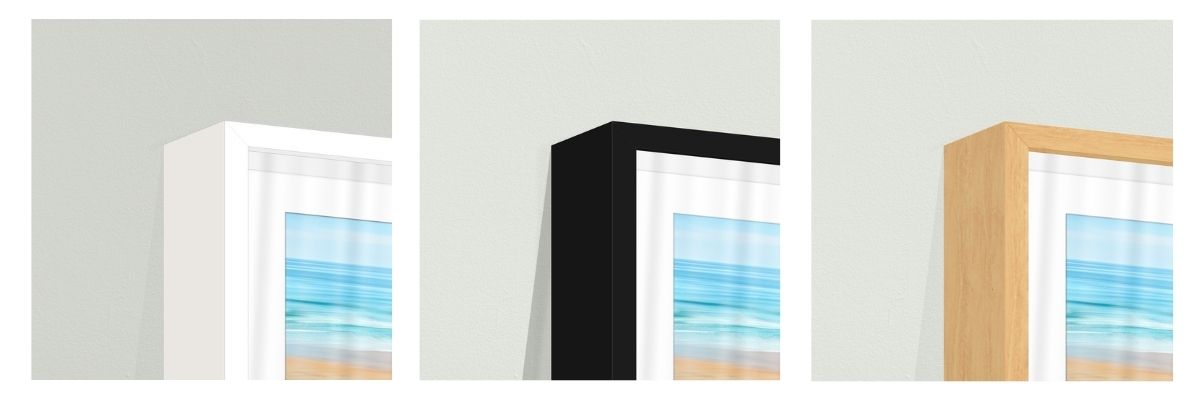Object Journeys – Caroline Phillips
Often when an artist chooses to invoke a memory of the past, they present a recognisable subject embodied through a portrait, a piece of clothing, or a personal talisman. In Now That Kin Have Gone, Karryn Argus and Mira Krulic each present us with objects and images twice removed, so we can’t quite recognise who or what is the subject. The recollections, memories and past connections that are present in their chosen objects are transformed into the present through processes of photography, sculpture and craft. Yet these works are recognisable as emphatically imbued with a sense of personal and bodily connection, and stir the inner self to a sense of intangible loss.
For six years Argus and Krulic have been connected through a shared relationship to art-making that explores the materiality of lived experience through minimalist means. Once again, in Now That Kin Have Gone, they share their experience of art-making forged out of shared encounters of grief, loss and memory, in works that form new connections across time and space. Both artists have taken personal objects from their past, that represent specific people who are now lost to them. They have interpreted and transformed these objects in ways that are not entirely clear to us, as vestiges of past relationships, intimacies and family connection, and as a strategy to combat grief. They ask a lot of these objects that, in turn, respond in surprising ways.
Argus has deployed brightly coloured components of a child’s experience, and merged them with needlepoint and sculptural assemblage, to create an unsettling sense of playful, yet disjointed remembrance. Her slightly disturbing stacks of plastic sit alongside soft objects that emit tense haptic feedback through their labour-intensive construction. Integrating fleeting images and remnants, the artist has transformed discarded actions and ideas of the past into new forms of alternate aspiration. I wonder if these actions trigger and reveal fresh wounds. Ideally, they are cathartic, and reveal a space of peace and respite from past pain.
Krulic summons a more optimistic interaction through the vibrancy of pure colour and light, as revealed in her explorations with photography. A selection of unknown items (there’s a hint they might be coloured glass forms) are transformed through her studio decisions and processes that simultaneously conceal and reveal the objects concerned. Transcribing form through digital means creates an entirely new image, but one that contains vestiges of the physical past, in this case the memory of her mother. But they are not memorials. The intense images created both by chance and intention, activate an embodied pause, rich with uplifting sensation, that amplifies the artists’ bond of positive connection.
Both Argus and Krulic have materialised sharp moments of experience, sensation and thought-generation that cut through the distinction between body and object. These works address the silence of trauma by activating ubiquitous household relics that might otherwise clutter the memory, through a stealthy yet purposeful Kondo-esque edit. Their personal journeys with these laden objects have traversed multiple moments of thinking, exploring, making, testing, ordering and shaping, to bring forth an aesthetics of memory that challenges the minimalist trope of objectivity. Through the intentional selection of these meaningful personal objects, that are then overlaid with instinctive processes of making, these works incite intense feeling, and bring the past directly into the present. I’m thankful they have generously brought others along with them on their open and heartfelt journey.
Caroline Phillips is a Melbourne artist and independent arts worker. She is Secretary of the Women’s Art Register.
Colour and the Cube – Emilie Jeffreys
Joined together by a single concept, artists Leonie Leivenzon and Mira Krulic have created new bodies of work for their collaborative show Modern Primaries: CMYK. Independently, their work adheres to the CMYK colour model, by combining and mixing only cyan (C), magenta (M), yellow (Y) and key (black/K). Despite working from the same foundational concept, Leivenzon and Krulic’s artworks are notably distinct from one another in medium and impression.
Together in the shared gallery space, at Rubicon ARI, are a series of small abstract oil paintings by Leonie Leivenzon paired with four large-scale photographic prints by Mira Krulic. The artworks dash in single file, circling the four walls of the gallery space. It appears like a stream of consciousness lost in the field of colour. The stream begins with Krulic’s work titled “All There Is”. It is commanding like a single car headlight in the night; the image explodes from a light purple focal point, reverberating rings of richening purple. The rippling effect of Krulic’s work is complemented by the swirling composition of Leivenzon’s oil paintings. The movement continues with a row of small canvases that digress in similar gradients, all uniquely twisted and textured with oil paints.
The dialogue between the artworks continues around the room. The install follows an instinctive emotional flow, marrying two mediums together through tone and colour. Absent are any hints of figuration or object. Only an indulgent smattering of paint on paint and a transcending abstract aura are illustrated.
Referring to the foundational concept, Leivenzon has strictly mixed only cyan, yellow, magenta and key (black) oil paints together. The colours vary from baby blue to army green to deep passionate magenta, all originating from scrap mixed paint, leftover from previous refined paintings. The materiality of oil paint and colour mixing is the work.
For Krulic, it is the opposite exercise of masking the medium of photography. The camera is the tool, but the work exists in the physical print and how the enhancement of light and colour produce an image that transcends our traditional notion of conventional photography. These works are reminiscent of the colour field painting movement that emerged in the mid-20th century. This influence is translated digitally through Krulic’s photography and colour adjustment editing, and then again trustingly translated by print to create these four echoing gradient abstract portals.
It is appropriate that Modern Primaries: CMYK encompasses a white cube gallery space. The surrounding white walls emulate the white base that the CYMK colour model requires to then subtract wavelengths of light by the addition of colour. There are no visual distractions. The gravitating pull of Krulic’s work anchors the gaze. In contrast, the scattered abstract expressive oil paintings by Leivenzon are formally very different. The gaze rests upon these mixed experiments and exerts the human quality of desperation, trying to find any hint of object or subject or instruction.
Modern Primaries: CMYK is a collaborative exhibition celebrating experimentation. Both artists embody the element of experimentation within their independent practice and together they explore the uncontrollable field of colour. Although notably distinct bodies of work from one another, their connection is through the unravelling of process and experimentation.
Emilie Jeffreys is an arts worker and artist in Naarm / Melbourne








